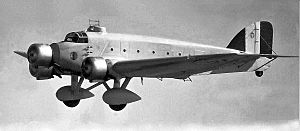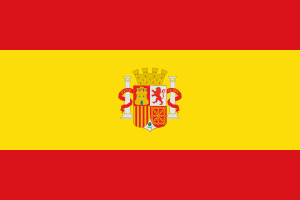Battle of Jarama facts for kids
Quick facts for kids Battle of Jarama |
|||||||
|---|---|---|---|---|---|---|---|
| Part of the Spanish Civil War | |||||||
 Italian SM.81 bomber, of same type as used by Nationalist air force |
|||||||
|
|||||||
| Belligerents | |||||||
|
|
|||||||
| Commanders and leaders | |||||||
| Strength | |||||||
| ~30,000 infantry (June 15) 30 tanks |
25,000–40,000 infantry, ~40 guns 55 tanks |
||||||
| Casualties and losses | |||||||
| 10,000–20,000 dead, wounded, or captured | 6,000–20,000 dead, wounded, or captured | ||||||
The Battle of Jarama was a major fight during the Spanish Civil War in February 1937. It took place near the Jarama River, east of Madrid, the capital of Spain. General Francisco Franco's Nationalist forces tried to break through the lines of the Republican army. They wanted to cut off Madrid from Valencia, which was the temporary Republican capital.
Both sides fought very hard for many days. The Nationalists, including tough Spanish Legionnaires and Moroccan soldiers, pushed back the Republicans. However, they could not achieve a full breakthrough. Republican counterattacks also failed to take back the lost land. This led to many soldiers being hurt or killed on both sides. The battle ended without a clear winner.
Contents
Why the Battle of Jarama Happened
By late 1936, the Nationalist forces, led by General Franco, had tried to capture Madrid but failed. They then decided to try a different plan. Their goal was to cut off Madrid from the rest of Republican Spain. They planned to cross the Jarama River, which was southeast of the city. This would block the main road connecting Madrid to Valencia.
General Emilio Mola was in charge of the Nationalist forces around Madrid. He planned the attack across the Jarama River. General José Enrique Varela led the troops on the ground. The Nationalists had about 25,000 soldiers, many of them experienced fighters. They also had support from German troops, including tanks and heavy guns.
The Nationalists first wanted to capture the west bank of the Jarama River and the high ground nearby. Then, they aimed to break through Republican defenses on the east side of the river. Their final goal was to take the towns of Vaciamadrid and Arganda. This would cut off Madrid from the south and east.
Nationalists Take the West Bank
The Nationalist attack began on February 5, 1937, after a lot of rain. They surprised the Republican soldiers on the west bank of the Jarama. The Nationalists advanced quickly in small groups, overpowering the unprepared Republican defenders.
One Nationalist group, led by Colonel García Escámez, attacked Ciempozuelos. They defeated the Republican forces there, causing them to lose many soldiers. Another group, led by Colonel Ricardo Rada, captured La Marañosa hill. This hill was very important because it overlooked both sides of the Jarama River. The Republican soldiers on La Marañosa fought bravely until the end.
By February 8, the Nationalists controlled the west bank of the Jarama. They had achieved their first goal. However, their advance in the middle of the battle line was slower. The Republican defense became stronger. Veteran brigades, led by Enrique Líster and El Campesino, arrived to help. They reorganized the Republican defenses. Heavy rain also caused the river to flood, stopping the fighting for two days.
Crossing the River

On February 11, a small group of Moroccan soldiers from the Nationalist side secretly crossed the river. They crept up to the positions of the Republican XIV International Brigade near the Pindoque railway bridge. Nationalist cavalry quickly followed them across the river.
Nearby, another Nationalist group bravely crossed the Arganda Bridge, even under heavy Republican fire. They managed to set up a small base on the other side. The Republicans had placed explosives on the bridge, but even though they blew them up, the bridge was not destroyed. Further south, Nationalist soldiers attacked the village of San Martín de la Vega. Republican machine gunners stopped their advance until Moroccan and Legionnaire soldiers fought their way in.
At this point, many Nationalist troops crossed the river. However, the Republicans were strongly dug in on the Pingarrón heights on the eastern bank. They kept firing artillery at the Nationalist positions. The Nationalist advance was slowed down by the Garibaldi Battalion, which held high ground near Arganda. Later, units of the XI International Brigade stopped a Nationalist push towards the Arganda–Colmenar road.
The Republicans then counterattacked twice with Soviet T-26 tanks. Nationalist artillery from La Marañosa hill stopped these attacks. When German planes from the Condor Legion appeared to support the Nationalists, Republican planes shot them down. For a few days, the Republican air force, mostly Soviet planes and pilots, controlled the skies. But then more Italian and Spanish Nationalist planes arrived. There was a big air battle over Arganda, and the Republican planes suffered many losses.
Republican Counterattacks

On February 14, the Republicans launched a large counterattack. They used fifty T-26 tanks, supported by soldiers, artillery, and air cover. This attack did not take back any land, but it caused more losses for the Nationalists and stopped their advance. The Nationalists called this day "el día triste del Jarama" ("the sad day of Jarama").
On February 17, General José Miaja took full command of the Republican front. He launched a major counter-offensive to clear the eastern bank of the Jarama. Forces led by Líster attacked the Pingarrón heights directly. They were forced back, losing up to half of their soldiers.
Another costly attack was made by troops under Juan Modesto. They attacked the Nationalist position at Marronosa from the north. Again, the Republicans failed to reach their goals and suffered heavy losses. However, in the northern part of the battle, the Nationalists were pushed back from Vaciamadrid and the Madrid–Valencia road.
More Republican counterattacks happened between February 23 and 27. General Gal ordered another attempt to storm the Nationalist stronghold at Pingarrón. This attack included 450 Americans from the Abraham Lincoln Brigade, led by Robert Merriman. These new soldiers, advancing without artillery or air support, were shot down as they moved towards the Nationalist lines. Captain Merriman was wounded. The Americans lost 120 dead and 175 wounded, which was 66% of their group.
Aftermath of the Battle
By the end of February, the battle lines had settled down. Both sides dug in and built strong defenses. It became very difficult for either side to attack successfully. Both the Nationalists and Republicans had suffered very heavy losses, with thousands of soldiers killed or wounded. Their troops were also tired and low on supplies.
Even though the Nationalists managed to cross the river and hold their positions, they could not capture the Madrid–Valencia road. This meant Madrid was still connected to the rest of Republican Spain. Because of this, the Jarama area lost its importance as a key battleground. It became a static front line, much like the Western Front in the First World War, with many trenches.
In March, Franco's Italian allies were also defeated at the Battle of Guadalajara. This ended Franco's hopes of cutting off Madrid from the rest of the country.
See also
 In Spanish: Batalla del Jarama para niños
In Spanish: Batalla del Jarama para niños
- Carolina Bunjes
- Jarama Valley (song)
- "Yank" Levy
- List of Spanish Republican military equipment of the Spanish Civil War
- List of Spanish Nationalist military equipment of the Spanish Civil War



